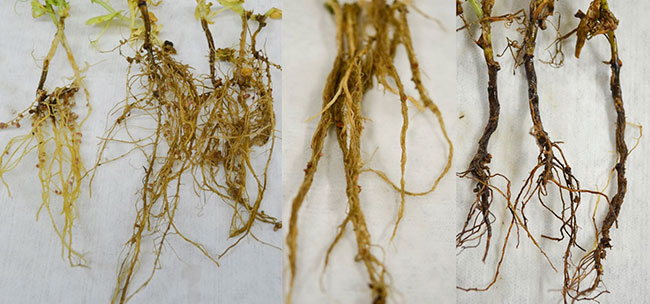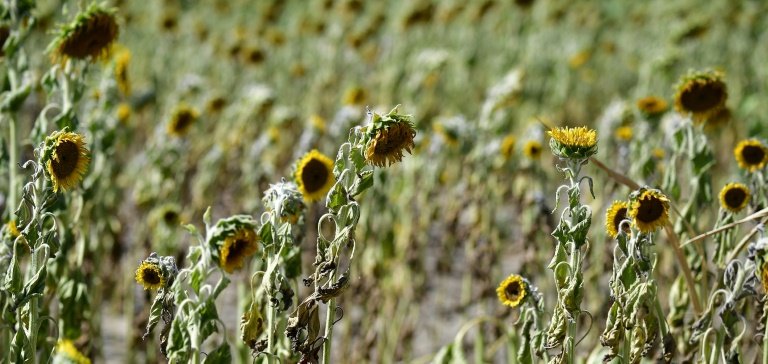1. Heavy Rainfall
We know that flowers need water to bloom, but how much water is too much? Consider the following:
Excessive rain on plants causes leaves to wilt and weakens the stems. Sometimes, the rain is so strong it simply damages the whole plant. As well, constant rain can cause fungal diseases such as anthracnose, which will also kill the whole flower. Mold also grows quicker in wet conditions.


"Root rot" from over-watering. Image sources (https://www.topcropmanager.com/root.) and (https://www.preen.com/too-much-rainLinks to an external site.) Retrieved 02/16/22.
Rain water contains nitrogen, which helps plantss grow healthier. BUT, excess nitrogen makes the flowers more vulnerable to disease and insects. Especially if flowers are smaller, it is more likely for them to develop unbalanced amounts of nitrogen.1
Also, root decay occurs when extra water reduces the oxygen in the soil. Without healthy roots, the flowers cannot grow.
Plus, rain keeps pollinators away as it washes off and dilutes pollen, which will outright inhibit the plant from blooming and reproducing. Regardless, it gets hard for pollinators to travel from flower to flower under wet conditions.
2. Intense Heat & Sunlight
While sunlight provides plants with energy, too much sun can dehydrate leaves, causing them to lose their green colour which is replaced with dark spots.

Browning of leaves due to sun exposure. Image Source: (https://www.ambius.com/plant-doctor/why-plants-turn-yellow). Retrieved 02/16/22.
Overexposure to the sun also causes a lack of moisture in the soil, hardening the soil beds. Thus, the flowers will wilt as there is no water for replenishment.
The science behind heat damage is that it makes molecules absorb more energy than they can handle. This creates reactive products of oxygen (e.g., peroxides), which can destroy the flower.2
Newly planted flowers are especially susceptible to stresses caused by the sun because they are still fragile as they undergo germination (seed growing into a plant).
3. Wind
Though wind is beneficial to reproduction, it impairs the overall growth of flowers. The force of strong winds can tear petals, shred leaves, and toss flowerpots. In fact, strong winds can cause plants to rock back and forth so violently that the roots and stem to begin to degenerate.


Image Sources: (https://giphy.com/gifs/flowers-wind) and (https://www.freeimages.com/photo/a-broken-flower.). Retrieved 02/16/22.
Further, constant winds pull moisture from leaves faster than the roots can draw it from the soil. This leads to wilting and death of the flower. Wind also makes the atmosphere colder, which usually freezes plant cells and interrupts the transfer of nutrients.
Rule of thumb: if the wind is above 30 miles (48 km) per hour, it will damage the flower!3
4. Drought
With the increase of global warming, droughts are becoming more commonplace around the world.
Droughts cause flowers to have no nectar, which alludes that no pollinators will visit the plant. This impacts reproduction because pollinators usually transfer flowers' male reproductive organs to other flowers. No pollinators = impaired reproduction!

Flowers during a period of drought. Image Source: (https://phys.org/news/2018-07-drought-breadbasket.html.). Retrieved 02/16/22.
As well, droughts cause water deficits in soil. This causes reverse osmosis in which cell membranes shrink/die, losing their nutrients.
Water deficits also reduce photosynthesis, which the process that helps flowers feed themselves. The poor flowers are left to starve and die.
During periods of drought, it is usually harder for communities to access water. So, even when they do have water, it probably won't be prioritized for watering plants.
Moreover, reduced water can shrink the actual size of the flower since there is not enough water for cell growth. Who wants a flower that won’t bloom to its full potential?

Image Source: (https://gfycat.com/gifs/search/watering+plant). Retrieved 02/16/22.
1https://www.westcoastseeds.com/blogs/garden-wisdom/too-much-nitrogenLinks to an external site..
2 https://www.science.org/content/article/too-much-good-thingLinks to an external site.
3 https://marinmg.ucanr.edu/EXTREME_CONDITIONSLinks to an external site.